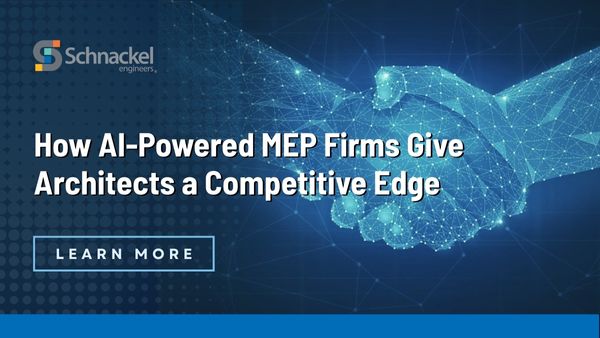How AI-Powered MEP Firms Give Architects a Competitive Edge

The architecture, engineering, and construction (AEC) industry is continually evolving, driven by innovation, efficiency, and technology. Architects face intense competition in delivering projects faster, more cost-effectively, and with fewer errors. Partnering with an AI-powered MEP (Mechanical, Electrical, and Plumbing) firm is becoming an essential strategy for architects looking to maintain and enhance their competitive edge. Here’s why:
1. Faster Project Completion, Winning More Work
In today’s fast-paced industry, speed matters. Firms equipped with AI-powered MEP capabilities significantly reduce the time traditionally spent on designing complex building systems. Advanced AI systems automate time-consuming processes, rapidly producing accurate and optimized MEP layouts. Architects benefit directly by receiving faster turnaround times, enabling them to complete projects ahead of competitors. This speed is an undeniable advantage, helping architects secure more projects and strengthen their market position.
2. Fewer Errors, Happier Clients, and Less Overhead during Construction Administration
AI systems efficiently handle repetitive and intricate tasks like sizing and routing wires, pipes, and ducts. By automating these processes, they substantially reduce errors that typically surface during construction. This results in fewer RFIs, reduced administrative overhead, and smoother construction phases. Architects experience fewer headaches, happier clients, and greater satisfaction, ultimately translating into increased repeat business and positive referrals.
3. Greater Design Freedom, Enabling Unique and Innovative Concepts
Architects are inherently creative, continuously pushing boundaries to design unique and inspiring spaces. AI-powered MEP solutions facilitate greater architectural freedom by optimizing infrastructure to occupy minimal space and reduce conflicts. Engineers, relieved of mundane tasks, can focus on complex problem-solving and enhancing the overall building experience. Architects thus gain the freedom to propose more innovative designs without being constrained by traditional MEP process limitations.
4. Lower Construction Costs, Better Buildings
Cost-efficiency is a critical factor for both architects and their clients. AI-driven MEP solutions optimize building system layouts, significantly lowering installation costs. Savings on infrastructure are redirected to enhancing architectural elements such as premium finishes, advanced fixtures, and additional amenities. Moreover, fewer errors and reduced changes during construction further ensure projects remain within budget, making architects highly appealing to value-driven clients.
5. Fewer Project Delays, Enhancing Reputation and Client Trust
Project delays can damage both reputation and profitability—and coordination challenges are often a major cause. AI-powered MEP designs reduce these delays by resolving clashes and inconsistencies early in the design process. By minimizing coordination issues across disciplines and streamlining communication, architects can keep projects on track. Consistently delivering on or ahead of schedule strengthens an architect’s reputation for reliability, builds client trust, and opens the door to more repeat work and long-term growth.
Schnackel Engineers and AI for MEP®: Delivering Competitive Advantages
At Schnackel Engineers, we’ve developed our proprietary AI-powered design software, AI for MEP®, to offer architects the competitive advantages they need. Our tool rapidly evaluates thousands of possible solutions, delivering optimized, accurate, and efficient MEP system designs faster and with fewer errors than is possible with traditional methods. The advantages include:
- Speed and Accuracy: Automating complex processes ensures accurate results, significantly reducing project timelines. Fewer errors means less time during Construction Administration resolving them.
- Enhanced Creativity: Optimized infrastructure layouts mean architects can explore more ambitious design concepts. In addition, since our engineers and designers are not burdened with routine calculations and drafting, they can spend more time focusing on what matters most – the user experience.
- Budget Optimization: AI-driven cost reductions translate into better resource allocation, improved finishes, and enhanced overall project value. The AI generated designs are less expensive to build and to operate over the life of the building.
- Sustainability Leadership: AI-driven efficiency helps projects effortlessly meet or exceed sustainability and energy goals. The reduction in labor and materials translates directly into both embodied carbon and operational carbon reduction, resulting in a more eco-friendly design.
Bottom Line
In a highly competitive architectural landscape, partnering with an AI-powered MEP firm like Schnackel Engineers offers a significant advantage. By leveraging cutting-edge AI technology, architects can achieve faster timelines, lower costs, enhanced creativity, and unmatched sustainability. Ultimately, choosing AI-powered solutions means better project outcomes, greater client satisfaction, and increased market competitiveness.
Are you ready to elevate your firm’s competitive advantage with AI-powered MEP design?
Contact Schnackel Engineers today to see how our cutting-edge solutions can transform your next project.
Comments